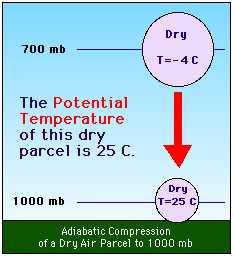Potential temperature and equivalent potential temperature
The most informative parameters for mesoscale and synoptic scale systems and the one very often used in vertical cross sections are potential temperature (θ) and equivalent potential temperature (θe) .
POTENTIAL TEMPERATURE is the temperature that an unsaturated parcel of dry air would have if brought adiabatically and reversibly from its initial state to a standard pressure (typically 1000 hPa).
To understand what a dry-adiabatic process is, suppose we have a parcel of air at 700 hPa level, being dry, in equilibrium and stable, with a temperature of -4oC. If we were to sink a volume of that air (without adding or taking away any heat to the air) to a height where the pressure was 1000 hPa, the volume of the parcel would decrease and the temperature would increase in order for the air to assume a pressure of 1000 hPa like the surrounding air. In other words the parcel would compress to a pressure of 1000 hPa. Because the parcel was sunk without adding heat, the change of state of the parcel is called a dry adiabatic change. Adiabatic simply means to alter the state of a gas without adding or withdrawing heat from the gas. The change in the temperature with the change in pressure is called the dry adiabatic lapse rate.
 The equation used to describe the
relationship between the temperature and pressure of the atmosphere
during adiabatic expansion and compression is referred
to as Poisson's equation and is written as
The equation used to describe the
relationship between the temperature and pressure of the atmosphere
during adiabatic expansion and compression is referred
to as Poisson's equation and is written as
where T0 is the temperature at the higher pressure in degrees Kelvin (K), T is the temperature at the lower pressure in degrees Kelvin, p0 is the higher pressure, and p is the lower pressure. The exponent value 0.286 is called the Poisson constant. This exponent is actually the ratio of the gas constant to the specific heat capacity at constant pressure for an ideal diatomic gas. It is often assumed to be 2/7 or 0.286.
For convenience of comparison, meteorologists have defined the potential temperature(θ) as the temperature an air parcel would have if it were expanded or compressed adiabatically to a pressure of 1000 hPa. To calculate potential temperature Poissons equation can be rewritten as:

where θ is the potential temperature, T is initial temperature in degrees K, and p is initial pressure in hPa.
Using a simple
| potential temperature calculator |
you can combine various pressures and temperatures to calculate potential temperature and get a better feeling about their relation to each other.
EQUIVALENT POTENTIAL TEMPERATURE (also called wet-equivalent potential temperature) is a thermodynamic quantity, with its natural logarithm proportional to the entropy of moist air, that is conserved in a reversible moist adiabatic process.
It is given most accurately as

where θe is the equivalent potential temperature, cpd is the heat capacity at constant pressure of dry air, rt is the total water mixing ratio, c is the heat capacity of liquid water, T is the temperature, Rd is the gas constant for dry air, pd is the partial pressure of dry air, p0 is a reference pressure (usually 100 kPa), Lv is the latent heat of vaporization, rv is the vapor mixing ratio, Rv is the gas constant for water vapor, and Η is the relative humidity.
Neglect of
the quantity rtc, where it appears, yields a
simpler expression with good accuracy.